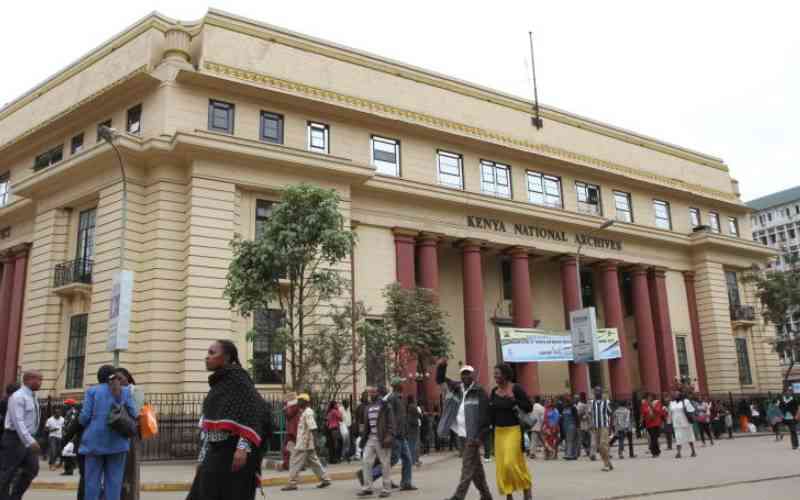 Many people have passed near The Kenya National Archives located on Moi Avenue next to Ambassadeur Hotel, but have no idea what really happens there. Random questions brings out the ignorance of many about this national treasure. To a taxi driver who operates at the parking adjacent to the building it is, “a repository for worn out currency before it is taken for incineration by concerned Government authorities.”
Many people have passed near The Kenya National Archives located on Moi Avenue next to Ambassadeur Hotel, but have no idea what really happens there. Random questions brings out the ignorance of many about this national treasure. To a taxi driver who operates at the parking adjacent to the building it is, “a repository for worn out currency before it is taken for incineration by concerned Government authorities.”
Never mind, the driver has been operating here for the past 12 years. Next came Fredrick Ouma*, a young man in his late 20s. When asked about the National Archives, with all the confidence he could muster he said, “I think it’s a museum where they keep Omweri, the famous snake from Nyanza. I’ve been meaning to visit the premises so that I can see what became of the creature.”
The next hour brought about more absurd responses. Others referred to the building as the Kenya National ‘Achievers’. Was it ignorance or pure misinformation that led to the tonnes of awkward answers?
“I’ve been working here for over 20 years and I usually get such hilarious answers myself when I randomly ask people what goes on or is kept here. Just like Kenya Cinema, most use it as a meeting point, but have no clue what happens in here,” said an employee of the National Archives who sought anonymity.
Established in 1978, the National Archives is home to over 680 million documents preceding the colonial area.
Missionary documents
“The colonial government started operations in 1895 but the oldest documents we have here are from as far back as 1845. These documents are attributed to the missionaries with the Church Missionary Society,” explained the employee.
“This building was built in 1928 and completed in 1931. It first housed National Bank of India, then Kenya Commercial Bank and then National Archives.” But how did that come about? “The State had acquired the building between 1971 and 1978 with the intention of housing the Transport and Licensing Board (TLB) thus forcing KCB to move across the street to Kencom House. But the design, space, location and the needs of an archival centre far outweighed that of the TLB. Thus, National Archives was conceived.”
It employed British style architecture just like The McMillan Library, and City Hall among others.
Movement of records from Nairobi – which were housed in the basement of Jogoo House – and other centres from all over Kenya like Mombasa, Kakamega, Nakuru, Kisumu and Nyeri, immediately commenced. (Some records are still kept at centers in these towns).
Precious materials
Currently, National Archives houses valuable artifacts, The Murumbi Collection, cultural materials, photos, footage, sculptures and priceless records. Over the years, it has proven to be an indispensible centre that provides research materials for journalists and scholars.
Its mandate, among others, is to make accessible records and archives to users, preserve public and private records and archives of permanent value and to advise public offices on the creation, care, control and use of public records.
To avoid deterioration, records are kept under a controlled environment away from humidity and sunlight. So far, a total of 12 million documents have been digitised and the process is still ongoing. National Archives has been promoting itself by encouraging students to visit.
Stay informed. Subscribe to our newsletter
 The Standard Group Plc is a
multi-media organization with investments in media platforms spanning newspaper
print operations, television, radio broadcasting, digital and online services. The
Standard Group is recognized as a leading multi-media house in Kenya with a key
influence in matters of national and international interest.
The Standard Group Plc is a
multi-media organization with investments in media platforms spanning newspaper
print operations, television, radio broadcasting, digital and online services. The
Standard Group is recognized as a leading multi-media house in Kenya with a key
influence in matters of national and international interest.
 The Standard Group Plc is a
multi-media organization with investments in media platforms spanning newspaper
print operations, television, radio broadcasting, digital and online services. The
Standard Group is recognized as a leading multi-media house in Kenya with a key
influence in matters of national and international interest.
The Standard Group Plc is a
multi-media organization with investments in media platforms spanning newspaper
print operations, television, radio broadcasting, digital and online services. The
Standard Group is recognized as a leading multi-media house in Kenya with a key
influence in matters of national and international interest.

 Many people have passed near The Kenya National Archives located on Moi Avenue next to Ambassadeur Hotel, but have no idea what really happens there. Random questions brings out the ignorance of many about this national treasure. To a taxi driver who operates at the parking adjacent to the building it is, “a repository for worn out currency before it is taken for incineration by concerned Government authorities.”
Many people have passed near The Kenya National Archives located on Moi Avenue next to Ambassadeur Hotel, but have no idea what really happens there. Random questions brings out the ignorance of many about this national treasure. To a taxi driver who operates at the parking adjacent to the building it is, “a repository for worn out currency before it is taken for incineration by concerned Government authorities.”





